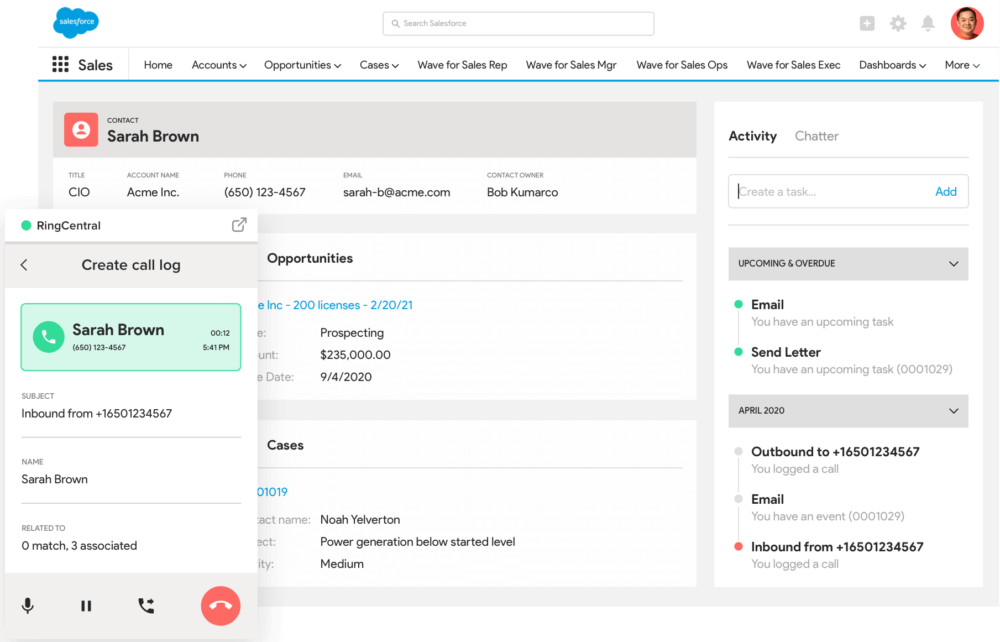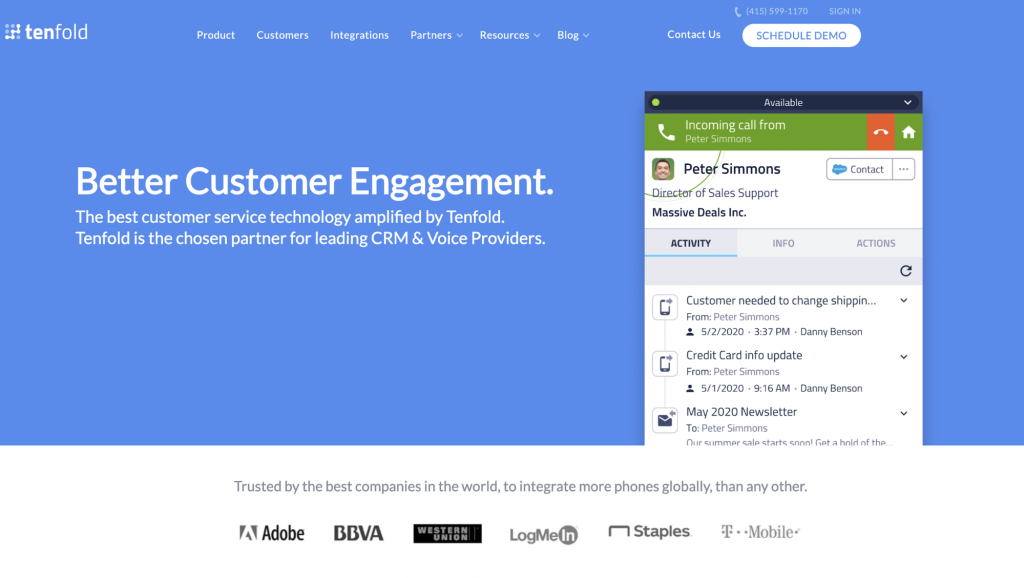Updated May 2020
Cold calling gets a bad reputation. Sales reps feel annoying, buyers feel harassed, and everyone feels awkward.
But should they really? After all, more than half of senior-level buyers (57%) actually prefer to be contacted via phone call.1
Maybe the issue isn’t cold calling, but the way we approach it.
Instead of just feeling awkward, why not use the right cold calling software? Combined with the right cold calling script, it can make for a seamless interaction that leaves the buyer feeling heard—and the sales rep feeling confident that they’ll close.
Working with the right tools, you can take your small business’s cold calling strategy to the next level, achieve your sales goals, and create a seamless selling experience.
In this post, we’ll cover:
- The benefits of using cold calling software
- The best cold calling software
- How to choose the right cold calling software for you
Up your prospecting game and close more deals with these free cold calling scripts. ☎️
What are the benefits of using cold calling software?
It’s understandable that investing in cold calling software might seem more suited for a larger company. How much work is it really for your few sales reps to dial the phone?
But between a good customer relationship management (CRM) software and the actual calling platform, the right software is crucial to your cold calling success. These software tools will help your team work efficiently, keep detailed notes, and make the most of every single lead.
Investing in the right sales software is an investment in the future of your business. Not only are you giving yourself the best shot at closing as many deals as possible today, but you’re also setting your team up for success as you grow.
Detailed notes in your CRM will help get everyone up to speed on new leads quickly, and having call recordings handy will help your new hires get onboarded quickly.
When you’re shopping for a cold calling app or software, look for automation features (like auto-dialing) and syncing that’ll make it so that data only needs to be entered once.
Now, let’s look at a few tools that’ll make your sales team more effective—and boost your bottom line.
What are some of the best cold calling software options out there?
While you’re creating your system for cold calling, there are a few levels of software that you’ll need to include. Obviously, you’ll want some kind of app to make the actual calls, but your toolbox doesn’t end there.
The right CRM can help you optimize that cold calling app by recording important call data as well as your sales notes and follow-up ideas.
By connecting your CRM and phone software, you can create a powerful system for converting leads.
The foundation: Start with the right CRM
The foundation of any good sales system is a central hub to keep track of activity—and that’s exactly what a CRM is. A good CRM doesn’t just track notes your sales team manually enters, it can also remind you about appointments, automatically collect call information, and sometimes even send follow-up emails.
Some of the most popular CRMs include Hubspot and Salesforce. When you’re choosing the best CRM for cold calling, think about what your business priorities are. Your CRM will be foundational to any sales systems you set up in the future, so keep those integration possibilities in mind.
When using your CRM for cold calling, the most important factor is training your sales team to take good call notes. Even the most expensive CRM isn’t going to help your team if they aren’t using it effectively.
For cold calling, your salespeople should, at a minimum, be taking detailed notes—whether the lead answered the phone, what topics were discussed, and any follow-up required. You may have other specific requirements as well, tailored to your business and your customers.
Some CRMs that are more robust actually offer cold calling software as well, which might be worth a try. Just keep in mind that it can become a “jack of all trades, master of none” situation.
If you’re using RingCentral as your business phone service or communication platform, you’re good to go with pretty much all the major CRMs. It integrates with Hubspot, Salesforce, and a number of other smaller CRMs too, like AgileCRM and Zoho.
The call: Dialing software for cold calling
To round out your cold calling system, you’ll need a dialing software. This is the software that actually allows your sales team to call potential customers on the phone—usually, through an app on their computer.
Choose a system with features that help your sales team manage their time productively, including automated dialers and integrated collaboration tools.
RingCentral Engage Voice
RingCentral’s probably best known for its all-in-one communication platform that includes messaging, video conferencing, and even a phone service—in a single app—but did you know it has a sales-focused product too?
If you want built-in integrations with CRMs, ease of use, and scalability, RingCentral Engage Voice is the cold calling solution for you. From its scripting feature to campaign management and dialing options, it’s an outbound calling tool designed for sales teams that make a ton of calls. Here’s a quick look at how it works:
RingCentral also integrates with lots of CRMs and beyond cold calling, it also keeps your team’s communication channels—inbound, outbound, and internal—all in one place. For example, here’s what the Salesforce integration looks like:

That means you can consolidate the number of tools you’re using (and spend less time on training for your team). Plus, you don’t have to switch between tabs as much while you’re working on different platforms.
One of the added perks of RingCentral for sales teams specifically is the call monitoring feature. If you’re training new sales reps, or just want to see where your team can improve, you can listen in on the call (the prospect doesn’t hear anything), and even hit a button to take over the call if your new rep needs a bit of help!
🕹️ Get a hands-on look at how high-performing sales teams are using RingCentral by booking a product tour:
💰 You can also use this calculator to see roughly how much your business could save by using RingCentral to support your team’s communications with clients, customers, and each other.
RingCentral is a PCMag’s Editors’ Choice Award winner because of its reliable service and easy-to-use communications platform (among other reasons)!
Toky
If task automation is a priority for you, Toky is an option to consider. It has a handy automated dialer and automated voicemail—for those 76% of calls from unknown numbers that go straight to voicemail.2
Just be sure that all of that automation doesn’t lead to an impersonal sales experience—encourage reps to maintain their lead research on LinkedIn or other online searches and to be intentional about listening to customers’ needs when they do connect.
One thing to note: Toky has a smaller list of integrations, so you’ll probably need to use a third-party tool like Zapier to integrate it with certain tools.
Aircall
If recordings and collaboration are important factors in your cold calling software, you might consider Aircall.
Aircall keeps your entire team on the same page through a shared inbox, where reps can add notes to calls, assign calls to teammates, and add tasks to each other’s to-do lists.
The nice-to-have: a CTI
When you think about cold calling software, you know you need the dialing software, and we just went over the importance of a good CRM. The missing component? The connection between the two.
Many CRMs integrate directly with your dialing software, and vice versa, but you can also use a tool called a computer-telephony integration (CTI) system.
A CTI isn’t necessarily a required cold calling software, but if you want the simplest integration between your CRM and dialing software, or if you want to track your call outcomes, this might be a type of cold calling software to consider investing in.
For instance, Tenfold is a CTI that simplifies the data entry process for your sales reps by connecting your CRM and your dialing software through a pop-up:

When you’re on an outbound or inbound call, Tenfold will display a pop-up on your computer screen. In this pop-up, you can click-to-call, log calls, and take notes.
The pop-up system also lets you move from tab to tab without losing track of your notes and call information.
A CTI keeps your CRM organized, since team members can attach call notes, recordings, transcripts, and notes to CRM records. That also means you can keep better track of customer interactions and conversion data.
How to choose the right cold calling software for you
As with any software, the best one for your team may not be the best one for every company. Small businesses have varying needs when it comes to sales tools, so it’s important to think about which features and factors are the most important for your team.
Here are the top features you’ll want to explore when shopping for cold calling sales tools for your small business:
1. Ease of use
It may seem basic, but if your cold calling software is a challenge to work with, your people won’t want to use it. The last thing you want is to spend money on a tool that no one is using. When you’re shopping for a cold calling software, be sure to give the free trial a try or schedule a quick demo to get a walkthrough of how intuitive the platform really is.
Don’t just consider the sales rep interface, though. Dig a little deeper into the admin settings and check to be sure you can easily add users, integrate with your existing sales apps, and access the data you need to measure effectiveness (so you can have an answer ready if anyone asks “Does cold calling work anymore?”)
If any of these steps are challenging to navigate, your cold calling software probably won’t easily integrate into your sales call planning process—and it could even become the kind of software headache that forces your team to use annoying workarounds and waste more time on data entry.
2. Integrations and customer journey tracking
Integrations might seem straightforward—or even unnecessary—if your business is small now. But as you grow, your sales team will likely need more technology to help them do their jobs, and it’s important that they all work together.
The key is to think holistically when it comes to software integrations. For instance, your sales team needs to communicate with the entire company, so your internal communications app will ideally need to connect with your cold calling software.
The right CRM is central to connecting all of the apps and tools your sales team uses on a daily basis, but you should check the integrations list of any new product you add to your arsenal.
Another factor when considering integrations is the ability to track the entire customer journey map, from lead to purchase and beyond. Be sure your cold calling system makes it easy to record activity in your CRM so you can measure every stage of your customer relationships.
3. Ability to track metrics
In addition to customer journey tracking through CRM integrations, check to make sure that your cold calling software has built-in metrics.
Especially as more and more sales teams work remotely and remote work becomes the default for many companies, it’s important to be able to keep an eye on how your sales staff is doing at a granular level.
Tracking metrics and seeing team activity within your cold calling software allows you to keep your entire team—remote or not—on the same page and on pace to meet their goals.
4. Call recording
While tracking metrics can give you the quantitative analysis tools you need to track team effectiveness, call recording allows you to dig into what is and isn’t working through a more qualitative lens.
Call recording can be a particularly useful tool as your team grows, allowing you to use effective calls as training materials (and not-so-effective calls as coaching opportunities). You’ll also be able to check in with new team members and help them see opportunities for improvement as they get up to speed.
Use call recordings in conjunction with data to identify why certain techniques—or certain sales reps—are more effective than others.
5. Scalability
Finally, while scalability might not be top of mind for your small business right now, if you anticipate growth in the future, you’ll want to know your options for adding users. Understand the system for adding more users and the costs associated with doing so, before you commit to a software for the long term.
Migrating software of any kind can be a painful ordeal, so understanding scalability now can save you from headaches in the future.
Find the right software for your cold calling system
Cold calling might feel like a thing of the past, but with the right software solution, you can bring it up to date and empower your sales team to meet their goals through cold calls.
It’s a simple formula—with the right CRM and an effective calling app, plus a strong connection between the two, you’ll have the cold calling tools you need to succeed.
1 rainsalestraining.com/blog/infographic-30-sales-prospecting-stats-and-what-they-mean-for-sellers
2 prnewswire.com/news-releases/americans-only-answer-half-of-all-calls-they-receive-on-their-mobile-phones-300785490.html
Originally published Jan 01, 2021, updated Jun 18, 2024






